How would you like to decrease your risk of injuries, improve your mobility and coordination, get stronger, and improve your conditioning? Oh, and not to mention get faster results from your training. Seems too good to be true, doesn’t it?
The truth is, whether you are an athlete training to get that competitive edge, a fitness enthusiast looking to change your physique, or an avid runner who is stuck at a desk eight hours per day, there is something more you could be doing. Something that will help you blast through your plateau, take time off of your races, and help to decrease and eliminate some of those nagging aches you feel throughout the day.
The Four Most Important Exercises You’re Probably Not Doing
The key is incorporating the following exercises into your fitness program. These exercises are the cream of the crop when it comes to improving your alignment, stability, and motor control – all of which are crucial and often overlooked aspects of training.
Loaded Carries
I want to talk about alignment for a minute. When I use this word most people think of being adjusted at the chiropractor because they were “out of alignment.” They speak of alignment like it is something that just happens, and something that someone else needs to fix. The truth is alignment is simply the position where our bodies work optimally. Where everything is where it should be and where we put the least amount of stress on our joints.
Alignment comes primarily from strong stabilizer muscles. If these muscles are not working properly and you add a load to the body, you will see your alignment fall apart. In simple terms, this means you aren’t showing good stability or motor control. If this lack of stability or motor control isn’t addressed, it will undoubtedly lead to pain and injury in the future. Even more, poor stability and motor control can actually lead to decreased performance and can prevent you from getting the results you should be getting.
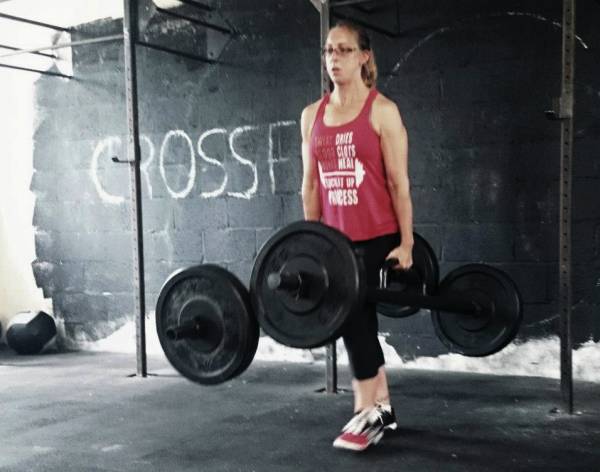
Enter loaded carries – one of the best ways to fix your alignment and train the stability of your shoulders, hips, core, and entire body. Put simply, loaded carries force you to find your alignment through improving your internal body awareness and firing up your stabilizing muscles.
You can think of loaded carries like a moving plank. They create unbelievable core stability while at the same time causing our rotator cuff muscles to activate. You see, our stability muscles are reflex driven. Pick up something heavy in a farmer’s walk and your body will automatically find proper alignment without conscious thought.
Don’t believe me? Think about the six-year-old holding hands with his dad when suddenly dad pulls him his arm so hard and quickly in order to avoid a huge puddle. Does the kid dislocate his shoulder? Did he consciously activate his rotator cuff muscles to avoid dislocation? Of course not, it happened automatically, by reflex.
This is where loaded carries are king of kings. They force us to stabilize and align our bodies simply by carrying something heavy, while having a huge metabolic demand at the same time. What could be better than that?
There are three types of loaded carries that you can do, all of which can be performed uni- or bilaterally: the waiter’s carry, racked carry, and farmer’s or suitcase carry. Try mixing it up and trying all of them!
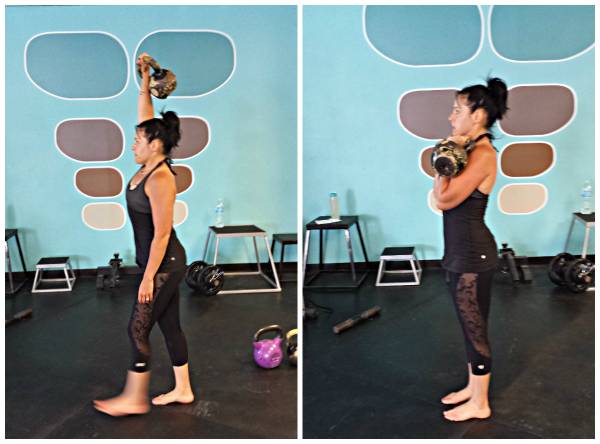
In the waiter’s carry, the arm must be locked out straight overhead, with no bend in the elbow. In the racked carry, the wrist should be in a neutral position with the kettlebell held close to midline, arm close to body.
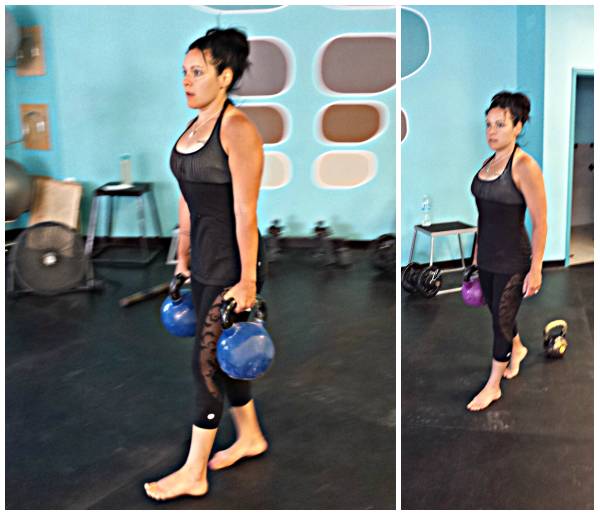
In the Farmer’s (two kettlebells) or suitcase (one kettlebell) carry, arms should be by side and you should be actively pushing the kettlebells down toward the ground.
The Turkish Get Up
While technically the Turkish get up (TGU) is a vertical carry, it deserves its own section. The TGU is one of my favorite exercises for prehabilitation, rehabilitation, and general strength and conditioning. Benefits include improved hip and thoracic spine mobility, core strength, shoulder stability, coordination, symmetry, balance, and proprioception, to name a few.
The TGU trains alignment similarly to the aforementioned carries, but the beauty of the TGU is that it utilizes what we call shoulder packing throughout the entire movement. This means that the proper positioning of both the scapula on the thoracic spine and humerus on the shoulder joint are maintained throughout the full movement – something often lost once we go overhead.
To better understand shoulder packing, you need to understand what should happen as our arm goes overhead. First, the scapula should rotate upwardly while maintaining its stable position against the thoracic spine. This happens by a force couple that exists between our upper and lower traps and serratus anterior.
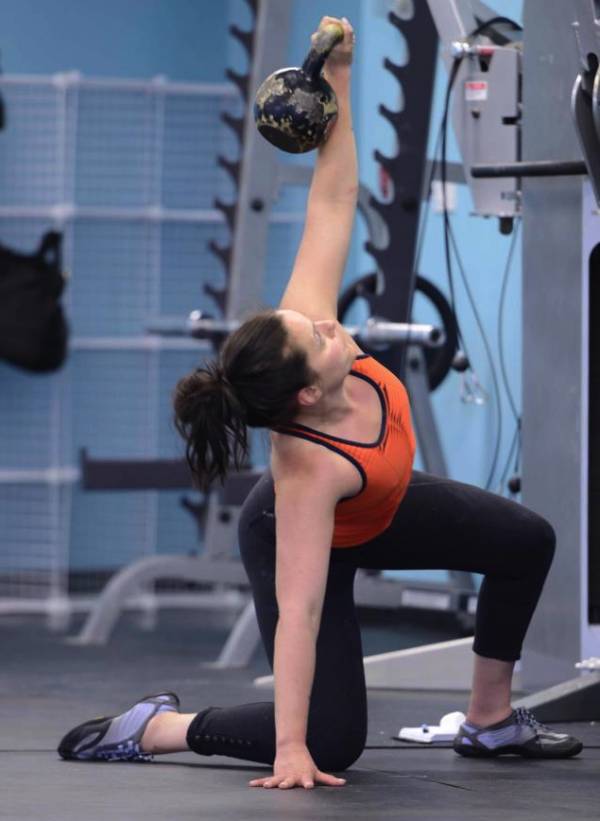
If this force couple doesn’t occur properly, the scapula will disengage from the thoracic spine in order to still achieve the movement. Although the end result is that we achieve the overhead position this way, the problem is our rotator cuff muscles then can’t properly fire and work to stabilize our arm since the scapula has disengaged. This leads to an unstable shoulder and to our upper trap muscles compensating, meaning an increased risk of injury to not only the shoulder and upper extremities, but also the neck. Not to mention an improper movement pattern that can lead to compensations down the entire body.
The fact that the TGU forces this packed position is why it is such a fantastic exercise. It allows the necessary muscles to get stronger, while at the same time re-patterning the movements to ensure that muscles are firing in the proper sequence. All of this, along with the addition of some killer strength gains, means there is no question this exercise should be a regular part of your training.
The Dumbbell Push Press
The push press is possibly one of the most advantageous and underutilized shoulder stability exercises out there. Unfortunately, overhead presses often get a bad rap when it comes to shoulders; however, there are times when they are absolutely helpful in both strengthening and improving stability.
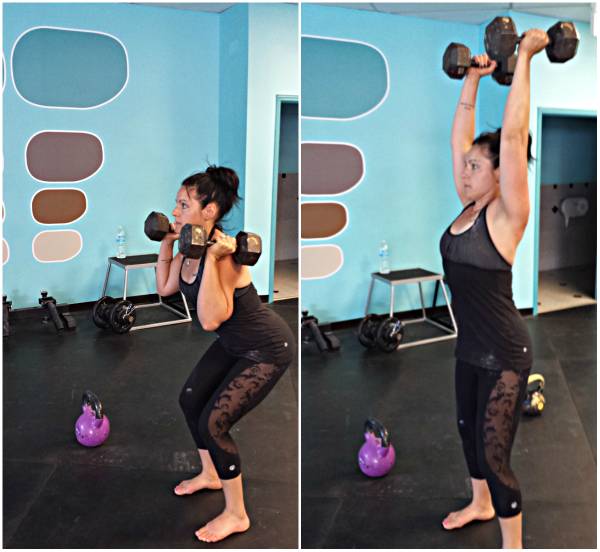
Why is the push press so amazing? In addition to it being an awesome exercise to increase your heart rate and strength, the best part about the push press is that you have to eccentrically control the weight from overhead – a weight that you couldn’t otherwise lift.
There are two phases of the press: the concentric and eccentric phase. In the concentric phase the muscles are shortening to produce a desired movement, while in the eccentric phase the muscle is under tension while lengthening in order to control the opposing movement.
Eccentric training actually has huge benefits for muscle growth, and is especially important when it comes to strengthening muscle tendons. In fact, eccentric training is key during rehabilitation of tendons after they have been injured and, even more importantly, this training can prevent these injuries from occurring in the first place.
Think about it. By using your legs to help you lift a heavier weight overhead, you then must control the weights as you lower them. When else would you get such great eccentric work if you couldn’t use your legs?
Barbell Glute Bridge
Lifestyle factors, such as sitting at a desk all day and driving long distances, mean that we are using our glutes and posterior chain less and less. Furthermore, we are constantly in a position of anterior flexion, causing our anterior musculature to become short and overactive and our posterior musculature to become lengthened and weak.
The kicker is that these posterior muscles, especially our glute muscles, are crucial for injury prevention and for hip movement and stability. This means we need to increase the strength of these muscles to ensure we maintain good stability and alignment. This is where the barbell glute bridge comes in – one of the best glute strengthening and activating exercises.
The best part about the glute bridge is that it not only strengthens, but also forces us to go into hip extension, a range of motion that is often lacking in many athletes. It is also easy to modify, as beginners can start with a basic bodyweight glute bridge, progressing to adding weight as they are able.
So, make sure to include the barbell glute bridge into your program. Not only will you activate and strengthen your glutes, but you will also look even better in those jeans of yours!
References:
1. Gray Cook, Lee Burton, and Dan John. Essentials of Coaching and Training Functional Continuums. Perform Better Functional Training Summit. Perform Better. Providence, Rhode Island, US. June 12, 2014.
2. J. Cowell, et al. “Eccentric muscle actions and how the strength and conditioning specialist might use them for a variety of purposes.” Strength and Conditioning Journal 34 (2012): 33-48.
3. R. Paine and M. Voight. “The role of the scapula.” International Journal of Sports Physical Therapy 8 (2013): 617-629.
Photo 1 courtesy of Shutterstock.
Photo 2 courtesy of Strength Education.






